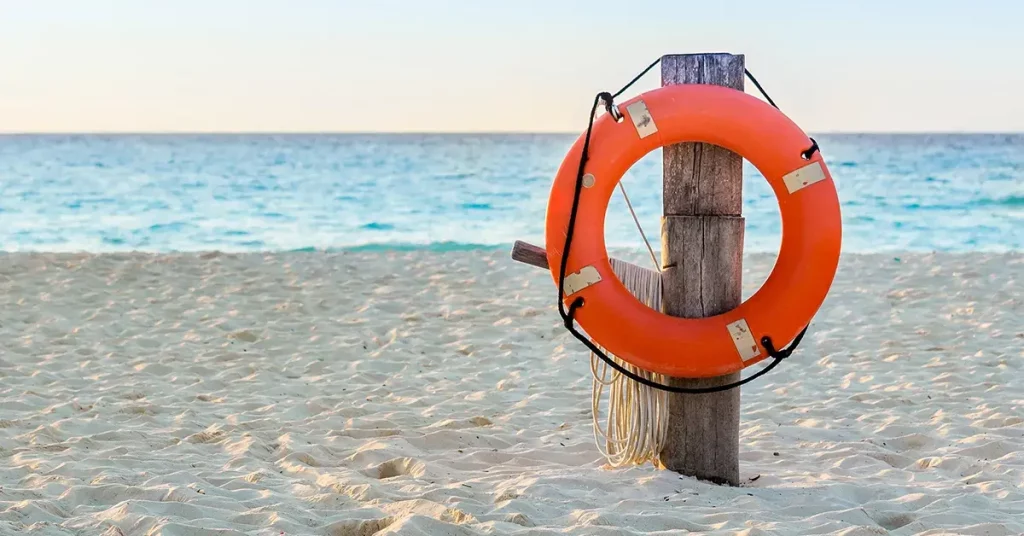When summers hit hard, all you want to do is frolic in the waves of the sea. While there’s no doubt that the beach is an incredible gift of nature to enjoy, it is also important to be aware of beach safety protocols.
The ocean’s breaking waves, rip currents and dangerous waves can sweep even the strongest swimmers away. If you don’t learn the important beach safety skills and teach your family too, you could leave yourself vulnerable to the many beach hazards.
With many years of experience on the beach, I have some important water safety and beach safety tips and skills to share with you. Once you perfect these along with your family, you’ll do a great job at being safe on your beach outings.
Watch for Rip Currents

Rip currents are the first beach hazards that the national oceanic authorities will warn you about. In fact, 80% of the rescues that the lifeguards perform are for cases of rip currents. If you follow the national oceanic updates, you’ll know that rip currents claim at least a hundred lives every year, if not more.
Rip currents are narrow yet strong currents flowing outward from the beach. They flow through the surf zone and pose a great threat to the safety of the swimmers, especially those who don’t know how to identify rip currents.
Although tricky, you can identify rip currents by keeping an eye on the surf zone. If you see that the waves are not breaking in a specific area, it is likely a rip current. If you don’t want to get caught in a rip current, then watch out for the following characteristics:
- Debris, seaweed, and foam move steadily in a line seawards
- A notable difference in the color of the water
- A channel of choppy, churning water
If you get caught in a rip current, do not fight it directly but rather swim out of it. Try to keep your panic at bay, conserve your energy and try floating.
Identify Lightning Strikes

Apart from dangerous waves and rip currents, lightning strikes are the next most common beach danger. Experts tell us that lightning strikes twelve miles away from a storm.
Hence, if you’re enjoying yourself on a beach when all of a sudden you hear thunder boom, you are already in danger of lightning strikes. It is always best to consult the national weather service before you leave for a beach outing with friends or family. Trust me, the open beach and water are the last places you should be when thunderstorms strike.
Talk with a Lifeguard or Beach Patrol

Water safety must be your primary concern when you plan to spend the day swimming in the sea. This is even more important if your younger kids will be joining you. The breaking waves can take the situation quickly out of your control and you may not have time to retreat at all.
Hence, the best practice is to always consult with the lifeguards or beach patrol authorities concerning the beach conditions. Discuss the water conditions, the surf tides, and whether it is safe to wade into the waters presently.
Only once they give their approval should you venture into the waves. In case you go swimming when the conditions are not too favorable, remember to swim close to where the lifeguards are.
Swim Parallel

Swimming parallel is the best thing to do in times when a rip current has you in its grip. Experts caution against the mistake of fighting a rip current directly. While panic is sure to set in moments like these, you must remember to stay calm and act wisely, for your life depends on it.
If you remember to swim parallel when in the grip of a rip current, it will make it easier for you to swim out of it. If you fail to do this and rather try swimming directly against the current, you will only tire out faster and fall vulnerable to far greater consequences.
Recognize Swimming Skills, Level and Strength

Swimming in the ocean is quite different from swimming in the pool. It requires a greater level of swimming skills and more strength too. If you didn’t know, this is also the reason why swimming in the ocean helps burn more calories.
Hence, those who are at the beginning or moderate level of swimming skills may struggle to cope with breaking waves and strong currents. You must not allow yourself or any family member, young or mature, to venture into the sea till they’re not accomplished swimmers. Only when you are confident of everybody’s competence against the surge should you allow them to swim in deeper water. Otherwise, make them stay by the shoreline.
Do Not Venture into Unsupervised Beaches

One of the greatest mistakes you can commit is going to beaches where there are no lifeguards, beach patrolling, or supervision. I wouldn’t be wrong to describe it as one of the deadliest hazards for you to leave your tiny little self vulnerable to the vast, monstrous sea. If you have not taken guide courses for open waters or are a trained swimmer, you could be inviting disaster for yourself.
At the very least, it is important to run a current check, and verify if your secluded beach choice is home to dangerous marine animals and if there’s an undertow. For the latter, you could run a small test. Take a small inflatable float, it could be a child’s arms float too. Leave it in the water and track it visually for a minute, until it is 20 km past the shore.
If your float moves more than 10m in the given time, you can figure there’s a powerful undertow there. If you still insist on swimming there alone, with friends or even the family, you’ll be welcoming grave danger for everyone.
Learn about the Warning Beach Flags and Signs

Often people fail to consider the importance of learning about warning flags and signs that usually line the beaches. People often fail to consult the national weather service too before planning a day out at the beach. By such negligence, they invite dangers not only upon themselves but also upon their families and friends.
Hence, more important than planning snacks, and organizing beach blankets, beach towels and drinks for everyone is to first seal their safety. A little training beforehand will always help. Teach your family that an ocean swimmer requires:
- Strength
- Technique
- Intelligence
Also teach everyone in your group that:
- A green flag means low hazard and they must exercise caution
- A single red flag means high hazard with strong currents and high surf
- Double red flags mean the beach is not open for swimming or visiting
- A yellow flag means a medium hazard
- And a purple flag means there are dangerous marine animals present in the waters.
Bonus Beach Safety Tips

Now that you’re all set with your picnic baskets, tanning beach chairs, and swimsuits, one last important measure is to share some beach tips with the party before you leave for your fun outing. These include:
- Everyone must remain sober. Assure them that you have stocked up cold beers in your portable coolers but you want them to stay sober till they plan to swim.
- Tell everyone to swim in the deeper waters only after they have consulted with the lifeguards and confirmed that the water conditions are favorable.
- All the younger kids must stay close to the adults and only on the shoreline.
- Everyone must stay well hydrated throughout the day. They should all drink plenty of water so that they are not at risk of a heat stroke.
- Everyone must apply sunscreen before heading out into the sun and reapply it after enough time has elapsed.
- Everyone must learn and repeat the steps to take in case a water emergency strikes.
Final Thoughts
Planning a beach outing with family and friends during summer is the best treat. After all, what can be more refreshing than rolling in the cold waves and building sandcastles under beach umbrellas? But before one hits the beach with their loved ones, it’s important to ensure all beach safety skills and awareness of rules are in place.
With the many beach dangers out there, a harmless day of fun could rapidly turn into a catastrophe God forbid. But if you take all proper precautionary measures, you will ensure that everyone has a good time while staying safe in the water.




